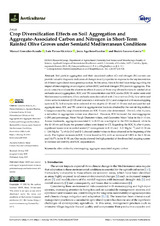Mostrar el registro sencillo del ítem
Crop Diversification Effects on Soil Aggregation and Aggregate-Associated Carbon and Nitrogen in Short-Term Rainfed Olive Groves under Semiarid Mediterranean Conditions
| dc.contributor.author | González-Rosado, Manuel | |
| dc.contributor.author | Parras-Alcántara, Luis | |
| dc.contributor.author | Aguilera-Huertas, Jesús | |
| dc.contributor.author | Lozano García, Beatriz | |
| dc.date.accessioned | 2022-07-08T11:42:56Z | |
| dc.date.available | 2022-07-08T11:42:56Z | |
| dc.date.issued | 2022 | |
| dc.identifier.uri | http://hdl.handle.net/10396/23551 | |
| dc.description.abstract | Soil particle aggregation and their associated carbon (C) and nitrogen (N) content can provide valuable diagnostic indicators of changes in soil properties in response to the implementation of different agricultural management practices. In this sense, there is limited knowledge regarding the impact of intercropping on soil organic carbon (SOC) and total nitrogen (TN) pools in aggregates. This study aimed to evaluate the short-term effect (4 years) of three crop diversifications in rainfed olive orchards on soil aggregation, SOC and TN concentration and SOC stocks (SOC-S) under semi-arid Mediterranean conditions. Olive orchards were diversified with Crocus sativus (D-S), Vicia sativa and Avena sativa in rotation (D-O) and Lavandula x intermedia (D-L) and compared with monocropping system (CT). Soil samples were collected at two depths (0–10 and 10–30 cm) and analysed for soil aggregate mass, SOC and TN content in aggregate-size fractions obtained by the wet-sieving method. Changes caused by crop diversifications on SOC-S were also determined. Overall, after 4 years, a reduction in aggregation values was observed. However, D-S increased the macroaggregates (>250 μm) percentage, Mean Weigh Diameter values, and Geometric Mean Value in the 0–10 cm. Across treatments, aggregate-associated C in 0–10 cm was higher in the D-S treatment, while in the 10–30 cm soil layer, the greatest values were found in CT. Regarding the SOC-S, after 4 years, significant losses were recorded under CT management in 0–10 cm (−1.21 Mg ha−1) and 10–30 cm (−0.84 Mg ha−1), while D-O and D-L showed similar values to those obtained at the beginning of the study. The highest increases in SOC-S were found in D-S, with an increase of 5.88% in the 0–10 cm and 14.47% in the 10–30 cm. Our results showed the high potential of the diversified cropping system to increase soil stability and SOC sequestration. | es_ES |
| dc.format.mimetype | application/pdf | es_ES |
| dc.language.iso | eng | es_ES |
| dc.publisher | MDPI | es_ES |
| dc.rights | https://creativecommons.org/licenses/by-nc-nd/4.0/ | es_ES |
| dc.source | Horticulturae 8(7), 618 (2022) | es_ES |
| dc.subject | Olive orchards | es_ES |
| dc.subject | Intercropping | es_ES |
| dc.subject | Aggregate-associated organic carbon | es_ES |
| dc.title | Crop Diversification Effects on Soil Aggregation and Aggregate-Associated Carbon and Nitrogen in Short-Term Rainfed Olive Groves under Semiarid Mediterranean Conditions | es_ES |
| dc.type | info:eu-repo/semantics/article | es_ES |
| dc.relation.publisherversion | https://doi.org/10.3390/horticulturae8070618 | es_ES |
| dc.relation.projectID | info:eu-repo/grantAgreement/EC/H2020/728003 (Diverfarming) | es_ES |
| dc.rights.accessRights | info:eu-repo/semantics/openAccess | es_ES |

